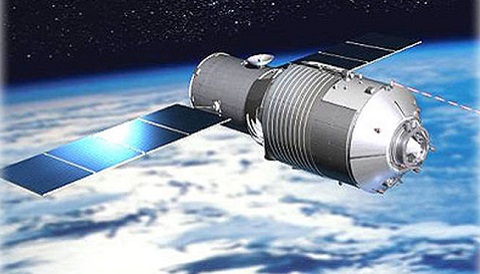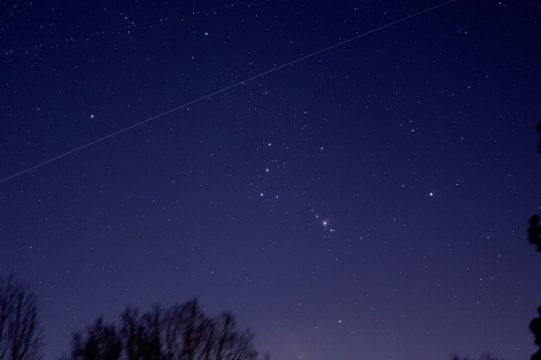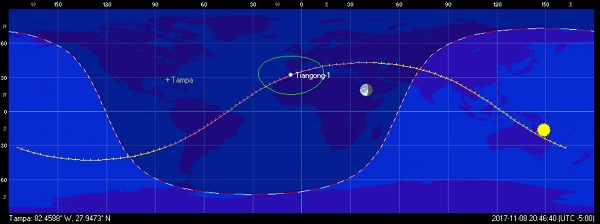Early next year, an international team will track the uncontrolled atmospheric reentry of Tiangong 1, China's first prototype space station.
| Update (February 5, 2018): The Aerospace Corporation has adjusted the expected date of re-entry: late March 2018, give or take two weeks. |

CMSE/China Space Engineering Office
A large, uncontrolled reentry is set for early 2018, as China's first prototype space station, Tiangong 1 (Chinese for “heavenly palace”) is set to burn up in Earth's atmosphere during its fall from orbit.
The China National Space Agency (CNSA) launched the school bus-sized, 8½-ton space station on September 29, 2011. It was the precursor to a full-scale space station that China is planning to complete by 2022. China used the precursor station to test automated docking and rendezvous techniques in November 2011, followed by two short visits by taikonauts (Chinese astronauts) aboard Shenzhou 9 and Shenzhou 10 in 2012 and 2013, respectively.
China extended the Tiangong 1 mission out to March 2016, but ground controllers lost contact with it late last year. In May 2017, China stated in a letter to the United Nations Office for Outer Space Affairs that the station's altitude was decaying at a rate of about 160 meters (0.1 mile) per day. The letter also stated that “orbital status and other information relating to Tiangong 1 will be posted on the website of the Chinese Space Agency.”
Meanwhile, China launched the slightly larger Tiangong 2 on September 15, 2016. This temporary station serves as a testbed for new technologies, in preparation for the more permanent Tiangong 3, expected to be operational in 2022.
China has charged forward with its own space station in part because it is a conspicuously absent player in the International Space Station program, as International Traffic in Arms Regulations (ITAR) currently prohibit a U.S. government agency such as NASA from sharing restricted technology with China.
But the Tiangong launches are just part of China's space efforts — the nation's space agency recently finished testing its new Tianzhou 1 automated cargo vehicle during rendezvous with Tiangong 2, it has also developed the Long March 5 heavy-lift rocket, which will deploy the Chang'e 5 lunar sample-return mission early next year.

CCTV
Reentry Observing Campaign
CNSA officials will work with the Inter-Agency Space Debris Coordination Committee (IADC) leading up to Tiangong 1's reentry. The IADC, an international forum of 13 space agencies concerned with issues related to space-debris mitigation and management, will use the impeding event as part of an upcoming campaign to improve prediction accuracy.
Tiangong 1's 300-km-high orbit is inclined 42.8° to Earth's equator, which means its reentry will occur between latitudes 43°N and 43°S — a pretty wide range!
“The date, time and geographic footprint of the reentry can only be predicted with large uncertainties,” says Holger Krag (ESA) in a recent press release. “Even shortly before reentry, only a very large time and geographical window can be estimated.”
Monitoring Space Debris
In addition to potential problems during reentry, space debris can pose a hazard to spacecraft and humans in space. Many organizations monitor space debris both large and small.
ESA tracks active and inactive satellites as part of its Space Situational Awareness program. The U.S. Air Force has deactivated its space surveillance system known as “Space Fence” in 2013 as it transitions to Lockheed Martin's next-generation system, set to come online in 2019. U.S. Air Force Space Command currently maintains space situational awareness using surveillance radar based out of Eglin Air Force Base, Florida, and Cavalier Air Force Station, North Dakota.
Another asset which keeps track of space junk optically is the Meter-Class Automated Telescope (MCAT) based on Ascension Island in the South Atlantic.

Chris Peat / Heavens-Above
Tiangong 1 is the largest object to reenter Earth's atmosphere since Phobos-Grunt, Russia’s 13-metric-ton failed Mars moon mission, which mostly burned up in January 2012.
The California-based Aerospace Corporation is currently projecting Tiangong 1's reentry to occur in early February 2018, give or take a month. As we approach that time, expect the window to narrow. Atmospheric drag and solar activity play a role in speeding up or slowing down reentry for satellites in low-Earth orbit.
Currently, the U.S. Joint Space Operations Center's (JSpOC) Space-Track site isn't listing Tiangong 1 in the reentry queue. Another reentry we're anticipating is the crippled Japanese Hitomi X-ray satellite, which fell silent in March 2016.
Tracking Tiangong
Spotting Tiangong 1 during dawn or dusk passes is easy, as the station is typically as bright as Sirius, at a magnitude of –1.

Chris Becke (@BeckePhysics)
Heavens-Above has a link on their homepage dedicated to Tiangong 1 and Tiangong 2, and a series of good evening passes for the southeastern U.S. for Tiangong 1 are coming up, starting on November 21st. I'll be curating these on Twitter in the hours leading up to each pass.
It'll be interesting to see how the Tiangong 1 reentry story unfolds, and where on Earth the historic station will finally meet its demise.

Orbitron
 4
4









Comments
Anthony Barreiro
November 10, 2017 at 7:34 pm
Will any pieces of this space station remain intact to hit the surface of the Earth? Are there any radioactive or other hazardous materials aboard?
You must be logged in to post a comment.
David DickinsonPost Author
November 11, 2017 at 8:25 am
Probably. The station is large enough that some fragments should make it to the surface intact. No word from China if there are any hazardous materials onboard, the usual hazard is leftover hydrazine propellant.
You must be logged in to post a comment.
Anthony Barreiro
November 13, 2017 at 12:02 am
Thanks David.
You must be logged in to post a comment.
Curt
November 12, 2017 at 2:02 pm
Did China ever explain how it "lost contact" with the derelict can? I mean was it accidental or negligent?
Most responsible space agencies (overt and covert) maintain enough fuel post mission to safely guide the spacecraft to a splashdown in some uninhabited area of the Pacific for launches in the past 20 years or so -- and especially the last 10. Did China actually intend to control their junk's re-entry or no? They need to provide some detailed information other than "oh look, a pretty falling star is coming."
You must be logged in to post a comment.
You must be logged in to post a comment.